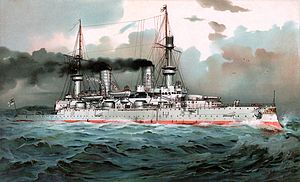SMS Kaiser Wilhelm II

Lithograph of Kaiser Wilhelm II in 1900.
|
|
| History | |
|---|---|
|
|
|
| Name: | Kaiser Wilhelm II |
| Namesake: | Wilhelm II |
| Builder: | Kaiserliche Werft Wilhelmshaven |
| Laid down: | October 1896 |
| Launched: | 14 September 1897 |
| Commissioned: | 13 February 1900 |
| Struck: | 17 March 1921 |
| Fate: | Scrapped in 1922 |
| General characteristics | |
| Class and type: | Kaiser Friedrich III-class pre-dreadnought battleship |
| Displacement: |
|
| Length: | 125.3 m (411 ft 1 in) |
| Beam: | 20.4 m (66 ft 11 in) |
| Draft: | 7.89 m (25 ft 11 in) |
| Installed power: | 12 coal-fired water-tube boilers, 12,822 ihp (9,561 kW) |
| Propulsion: | 3 shafts, triple-expansion engines |
| Speed: | 17.5 knots (32.4 km/h; 20.1 mph) |
| Range: | 3,420 nmi (6,330 km; 3,940 mi) at 10 knots (19 km/h; 12 mph) |
| Complement: |
|
| Armament: |
|
| Armor: |
|
SMS Kaiser Wilhelm II ("His Majesty's Ship Emperor William II") was the second ship of the Kaiser Friedrich III class of pre-dreadnought battleships. She was built at the Imperial Dockyard in Wilhelmshaven and launched on 14 September 1897. The ship was commissioned into the fleet as its flagship on 13 February 1900. Kaiser Wilhelm II was armed with a main battery of four 24-centimeter (9.45 in) guns in two twin turrets. She was powered by triple expansion engines that delivered a top speed of 17.5 knots (32.4 km/h; 20.1 mph).
Kaiser Wilhelm II served as the flagship of the Active Battle Fleet until 1906, participating in numerous fleet training exercises and visits to foreign ports. She was replaced as flagship by the new battleship SMS Deutschland. After the new dreadnought battleships began entering service in 1908, Kaiser Wilhelm II was decommissioned and put into reserve. She was reactivated in 1910 for training ship duties in the Baltic, but was again taken out of service in 1912.
With the outbreak of World War I in August 1914, Kaiser Wilhelm II and her sisters were brought back into active duty as coastal defense ships in the V Battle Squadron. Her age, coupled with shortages of ship crews, led to her withdrawal from this role in February 1915, after which she served as a command ship for the High Seas Fleet, based in Wilhelmshaven. Following the end of the war in November 1918, Kaiser Wilhelm II was stricken from the navy list and sold for scrap in the early 1920s. Her bow ornament is preserved at the Military History Museum of the Bundeswehr in Dresden.
Kaiser Wilhelm II was 125.3 m (411 ft 1.07 in) long overall and had a beam of 20.4 m (66 ft 11.15 in). Her draft was 7.89 m (25 ft 10.63 in) forward and 8.25 m (27 ft 0.80 in) aft. The ship was powered by three 3-cylinder vertical triple-expansion steam engines that drove three screw propellers. Steam was provided by four marine-type and eight cylindrical water-tube boilers, all of which burned coal. Kaiser Wilhelm II's powerplant was rated at 12,822 indicated horsepower (9,561 kW), which generated a top speed of 17.5 knots (32.4 km/h; 20.1 mph). She had a normal crew of 39 officers and 612 enlisted men; while serving as the fleet flagship, she carried an additional admiral's staff of 12 officers and 51–63 enlisted men.
...
Wikipedia
